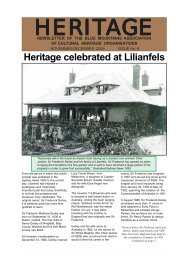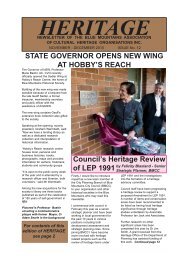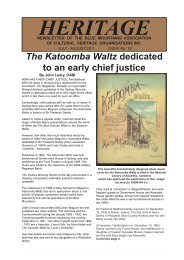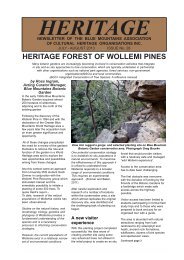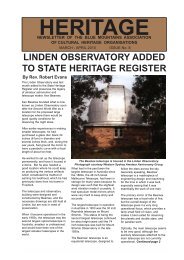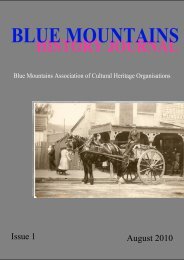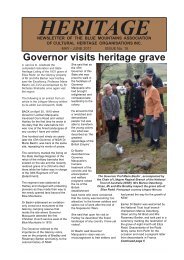Newsletter No - Blue Mountains Association of Cultural Heritage ...
Newsletter No - Blue Mountains Association of Cultural Heritage ...
Newsletter No - Blue Mountains Association of Cultural Heritage ...
Create successful ePaper yourself
Turn your PDF publications into a flip-book with our unique Google optimized e-Paper software.
World War 2 in the <strong>Blue</strong> <strong>Mountains</strong>By Joan EdwardsHOW did mountains people liveduring WW2?The common view was that warwould be repeat <strong>of</strong> 1914-1918; anexpeditionary force would beformed, go overseas, women wouldsend knitted socks and foodparcels, and war would be “overthere”.The Commonwealth enactedseveral pieces <strong>of</strong> legislation in thefirst week including banning certainimports, price controls andregulation <strong>of</strong> enemy aliens.Within the background <strong>of</strong>international politics and events, amere 7 million Australians occupiedthis island nation, many <strong>of</strong> whomstill called Britain “home” eventhough they had never been there.The Commonwealth Governmentdeclared the narrow coastal beltfrom Newcastle to Wollongong asthe priority area, ignoring the smallmountain settlements with dairies,poultry farms and piggeries, theholiday destinations <strong>of</strong> the uppermountains and the Lithgow Valleyindustrial area yet to recover fromthe depression.The significance <strong>of</strong> the area was notfully realised until 1942.Censorship determined what thepublic was allowed to know as wellas what the government wantedthem to believe – not necessarilythe facts.Many variations <strong>of</strong> the facts haveemerged over the years so it hasbeen necessary to rely on Trove’sdigitised major metropolitannewspapers for the wartime versionto which I have been able to addreleased information, extantnewspapers and records, oralhistories, reminiscences andunexpected, once restricted,archival material.There are several recurring themesall <strong>of</strong> which relate to the political,military, social and economicconditions at the time.Rationing was in force, some itemswere on the coupon system, othersProviding an escort to Wentworth Falls station for a patient allowed togo homewhen shopkeepers eked out theirsupplies to regular customers.Creativity and ingenuity wereparamount as local ladies driedused tea leaves to bulk out the<strong>of</strong>ficial supply sufficient for two cupsper day, or use golden syrup whenno egg was available to bind acake.Similarly they could dodge the holesin Dad’s worn out trousers, turnthem inside out and create newtrousers for the son.One pre-war development at theSmall Arms Factory, Lithgow was torevert from peacetime orders suchas golf club heads and handcuffsback to guns for which they werefamed in WW1.The output <strong>of</strong> Bren guns wasoutstanding especially in view <strong>of</strong>strikes, not receiving full set <strong>of</strong> blueprints or tools and under trainedworkforce.Lithgow’s coal mines, electricitygeneration, woollen mills, potteryworks and nearby Portland CementWorks all contributed to the wareffort.Goods to and from these locationscrossed the mountains by the onedirect road or rail line through the<strong>Blue</strong> <strong>Mountains</strong>.Lithgow could not house the everincreasing workforce so shantycamps developed.Secondary medical screening usingX-rays identified tuberculosis inmany recently enlisted personnel.In numerous cases it was two orthree weeks after attestation so theywere discharged into the care <strong>of</strong> theRed Cross at Bodington Sanatoriumat Wentworth Falls.Medical advances in T.B. treatmentwere in their infancy and Bodingtonbecame recognised for its care.Other male TB patients were nearbyat the Queen Victoria Homes withfewer amenities.Activity increased in the desperatedays <strong>of</strong> 1942. Brownouts were inforce, and all signage removed fromstreets and railway stations.Street lighting and vehicleheadlights were hooded.In addition to usual voluntarysupport services, volunteersundertook roles within the NationalEmergency Services (NES) aswardens, first aiders, ambulancedrivers and filled any other positionsas required.Several centres produced hundreds<strong>of</strong> camouflage nets, while otherstook up the challenge and joinedthe Volunteer Air Observers Corps(plane spotters) and provided 24hour service at Wentworth Falls andBlackheath.Continued page 9HERITAGE 8July - August 2012



